Meteorology and Flight Safety
The adverse weather conditions for the flight can be contributing factors of aerial accidents. Therefore, weather information has value for flight safety.
The dissemination of studies concerning the importance of meteorology in aeronautical occurrences is in line with the purpose of the PSOE-ANAC Implementation Program.
A study conducted by the National Aviation Safety Data Analysis Center ( NASDAC) from 1992 to 2001 and data from the Aviation Safety Information and Information System Analysis and Sharing (ASIAS), developed by the Federal Aviation Administration (FAA) from 2003 to 2007, found that approximately 21% of all aeronautical accidents had meteorological factors among the possible contributing factors. Both studies used data from the National Transportation Safety Board (NTSB).
The figure below presents, in percentage, the different types of contributing meteorological factors.
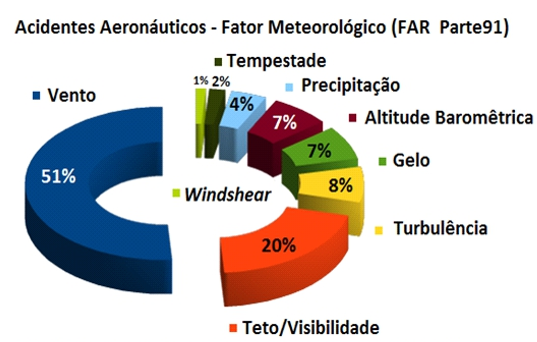
Source: NTSB Weather Related Accidents
The study was consolidated in a report, which aims to guide the aviation community, regarding the correlation between air crashes and adverse weather conditions for the flight.
The analysis methodology considered that the number of accidents and the correlation with the adverse weather conditions depend on the category of operation of the aircraft and that an accident may involve multiple atmospheric conditions.
We also presented a comparative analysis of the influence of meteorological factors on accidents, by flight phase.
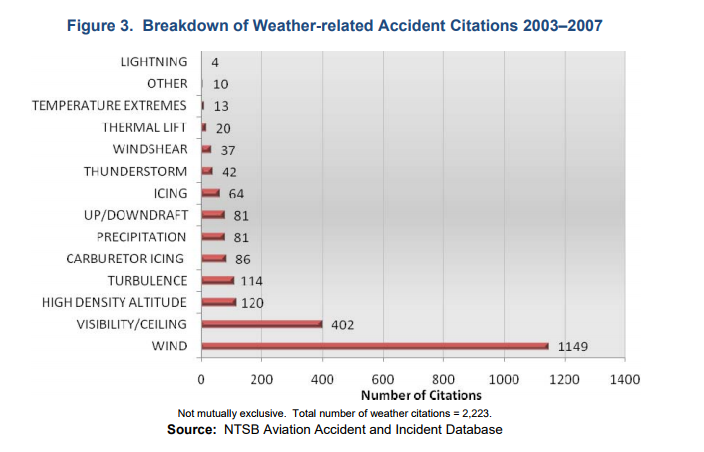
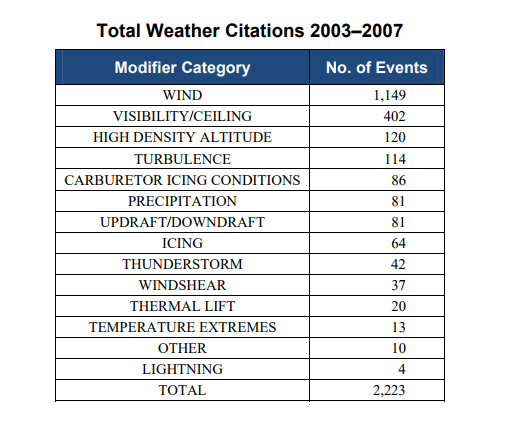
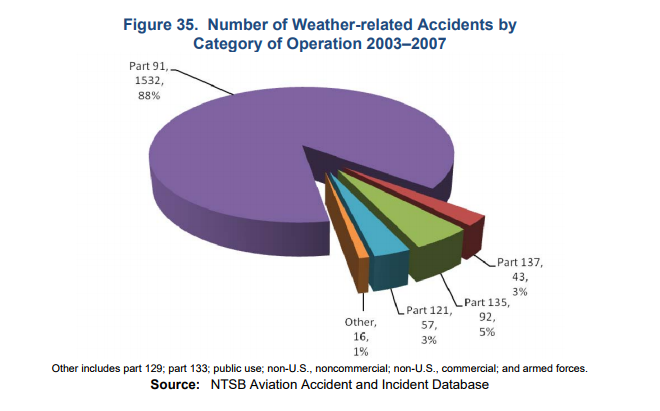
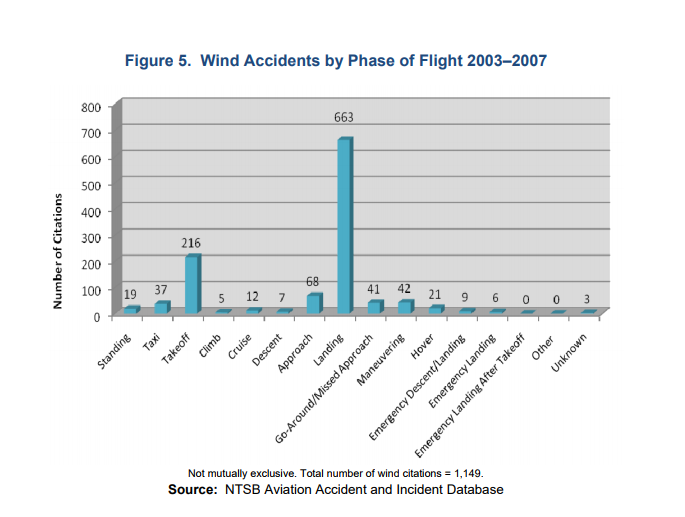
Access the full contents of the NTSB Weather Related Accidents report in full .
Also check out the National Transportation Safety Board (NTSB) report , which analyzes accident data from 2002 to 2013, where turbulence was a contributing cause or factor.
The National Transportation Safety Board has also developed studies to better understand the risk factors that are associated with accidents that occur in weather conditions characterized by BMI or with restricted visibility.
The researchers collected data from 72 general aviation accidents that occurred between August 2003 and April 2004 and concluded that about two-thirds of all general aviation (GA) accidents occurring under instrument meteorological conditions (BMI) are fatal .
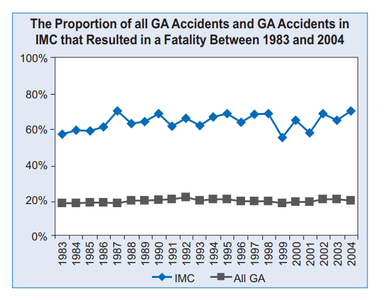
Source: Safety Study NTSB / SS-05/01
Historical accident data suggest that low visibility flights represent a high risk for general aviation operations.
The NTSB analysis also revealed that the measures needed to mitigate these risk factors should be adopted in three broad areas:
- Ensuring a minimum level of proficiency for all pilots so that they are able to recognize and respond safely to phenomena meteorological conditions for flight;
- Provide additional support for pilots whose performance history indicates a greater risk of engaging in accidents due to adverse weather conditions;
- Provide general aviation pilots with additional guidance on the sources of meteorological information available in the flight planning phase.
The study also revealed that reinforcement in training and periodic assessment of meteorological issues may be necessary to ensure that pilots maintain satisfactory knowledge and skills related to the weather forecast for a safe flight.
Another important conclusion of this study is that general aviation pilots are required to routinely consult alternative sources of flight meteorological conditions that are not available in a standard meteorological briefing.
Among the recommendations that have been issued to the Federal Aviation Administration (FAA) are:
- The inclusion of training for the recognition of adverse weather conditions in ground and in flight and the proper interpretation of aeronautical meteorological bulletins;
- The establishment of a proficiency index to be required for pilots in aeronautical meteorological knowledge tests;
- The development of guidance materials that encourage the use of the Internet and other sources to obtain meteorological information for the flight, when these are not available in a standard meteorological briefing.
In another study also related to the influence of meteorology on flight safety, the National Transportation Safety Board investigated 16 accidents and incidents that occurred between March 2012 and December 2015 and had as contributing factors deficiencies in the treatment of PIREP information.
According to the study, delays in sending this type of message, errors or loss of data contributed to reduce the crew's perception of adverse weather conditions for the flight.
PIREPs are reports made by pilots who briefly describe in-flight meteorological conditions and constitute an important source of meteorological information to avoid inadvertent encounters with adverse weather conditions and to prevent accidents.
This information is also used by meteorologists to assess the quality of their forecasts and to improve the weather products offered to pilots, especially products related to turbulence prediction and the occurrence of ice formation.
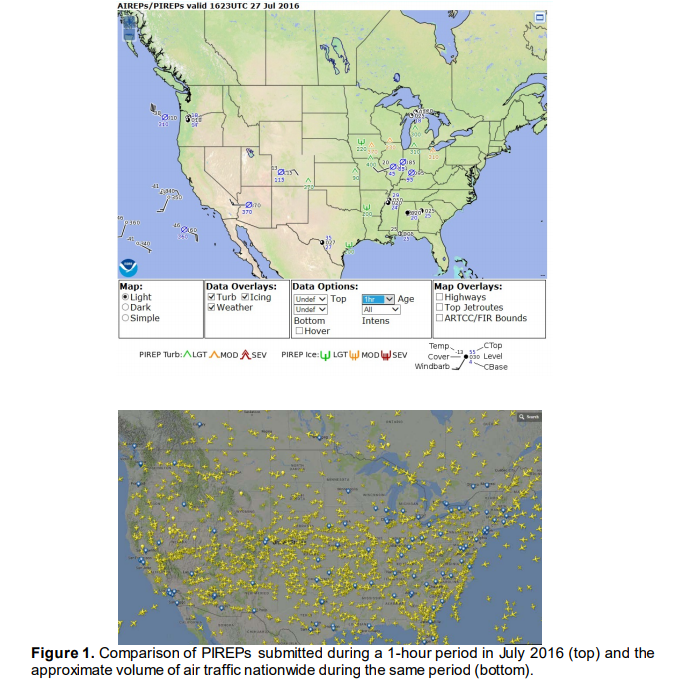
Source: Improving Pilot Weather Report Submission and Dissemination to Benefit Safety in the National Airspace System - NTSB / SIR-17/02 - PB2017-101424
Click here to access the Report Improving Pilot Weather Report Submission and Dissemination to Benefit Safety in the National Airspace System.
The Flight Safety Foundation (FSF), an independent, non-profit international research, education, advocacy and publication organization in the field of aviation security, which brings together aviation professionals from all sectors to help solve the security problems faced by the industry, discloses in its portal information on accidents in which adverse weather conditions were possible contributing factors.
Reports of accidents are presented whose causes may be related to the following meteorological factors: volcanic ash, heavy rains, ice formation in aircraft, electric shocks, sandstorm, thunderstorms, turbulence, wind gusts, fog, wind shear.
Click here to access the database.
In Brazil, according to data from the Center for Research and Prevention of Aeronautical Accidents (CENIPA), adverse weather conditions are among the possible contributing factors of aeronautical events (accidents, serious incidents and incidents) that have been recorded in the last 10 years.

Source: CENIPA. Data extracted from the system on 08/14/2017
This information is consolidated in the SIPAER Panel, a data visualization tool developed by CENIPA that presents the aeronautical occurrences notified through the CENIPA-05 Data Sheet: http://www2.fab.mil.br/cenipa/index.php/destaques/1079 -painter-sipaer
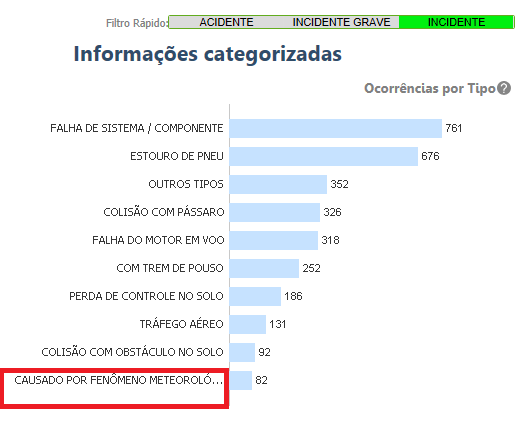
Source: CENIPA. Data extracted from the system on 08/14/2017.
According to the Brazilian Aviation Statistical Outlook 2016, published at http://www2.fab.mil.br/cenipa/index.php/estatisticas/panorama , which presented the percentage of possible contributing factors in accidents and serious incidents in the last 10 years, adverse weather conditions for flight have had higher incidence than important contributing factors such as: decision making, cabin coordination, organizational culture and perception.

Source: CENIPA
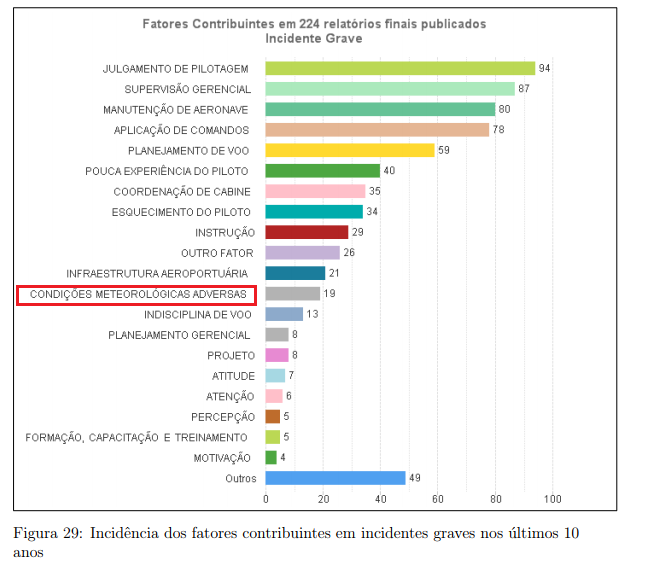
Source: CENIPA
In the agricultural segment, among the 66 possible contributing factors, adverse weather conditions are among the 10 most frequent in serious incident investigations, surpassing the instruction and presenting the same percentage of frequency that was presented in relation to the pilot's lack of experience.
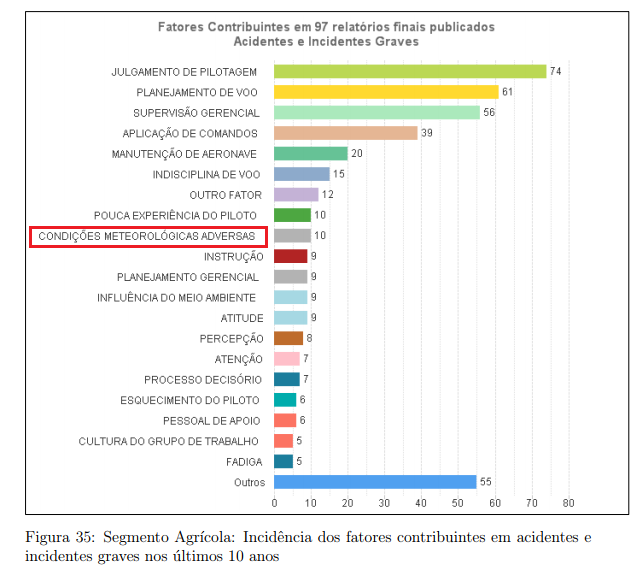
Source: CENIPA
Adverse weather conditions were also among the 10 most frequent possible contributing factors in the particular and regular segments.
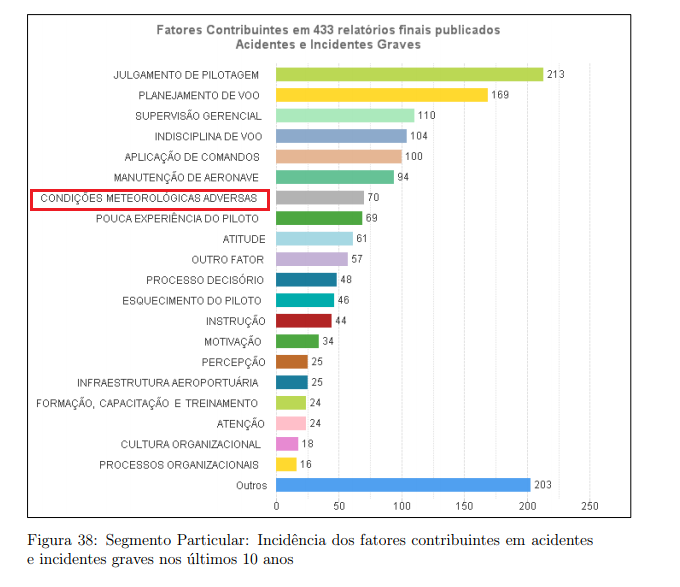
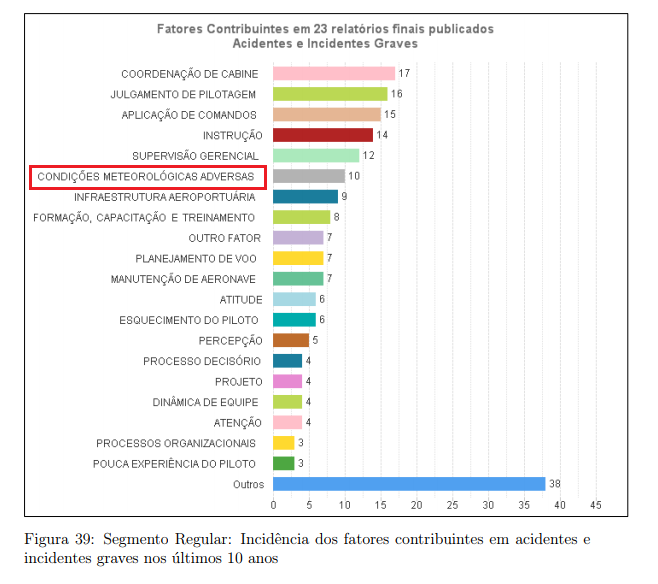 Source: CENIPA
Source: CENIPA

RBHA 91 - Regras gerais de operação para aeronaves civis
91.145 – INFORMAÇÃO SOBRE CONDIÇÕES POTENCIALMENTE PERIGOSAS
Sempre que um piloto encontrar em voo uma condição meteorológica potencialmente perigosa ou outra irregularidade cuja divulgação esse piloto considerar essencial à segurança de outros voos, ele deve notificar uma apropriada estação rádio de solo tão cedo quanto praticável.

RBAC 135 - Requisitos operacionais: operações complementares e por demanda.
SUBPARTE B
OPERAÇÕES DE VOO
135.67 Informação sobre condições meteorológicas potencialmente perigosas e irregularidades em instalações de comunicações ou navegação
Sempre que um piloto encontrar em voo uma condição meteorológica potencialmente perigosa ou uma irregularidade em instalações de comunicações ou de navegação, cuja divulgação esse piloto considerar essencial à segurança de outros voos, ele deve notificar uma apropriada estação rádio de solo tão cedo quanto praticável.

RBAC 121 – Requisitos operacionais: operações domésticas, de bandeira e suplementares
121.357 Requisitos para radar meteorológico de bordo
(a) Ninguém pode operar qualquer avião categoria transporte (exceto aviões tipo C-46) ou um avião não incluído na categoria transporte de tipo certificado após 31 de dezembro de 1964, a menos que um equipamento de radar meteorológico aprovado tenha sido instalado no avião.
(c) Cada pessoa operando um avião no qual seja requerido um radar meteorológico instalado, quando voando esse avião segundo este regulamento, deve atender ao seguinte:
(1) despacho. Ninguém pode despachar um avião (ou iniciar o voo de um avião no caso de detentor de certificado que não usa um sistema de despacho) em voo VFR noturno ou IFR se as informações ou previsões meteorológicas conhecidas indicarem que trovoadas ou outros fenômenos meteorológicos potencialmente perigosos, capazes de serem detectados por um radar meteorológico de bordo, são esperados ao longo da rota a ser voada, a menos que o radar meteorológico do avião esteja em condições operativas satisfatórias;
(2) se o radar meteorológico tornar-se inoperante em rota, o avião deve passar a ser operado de acordo com as instruções e procedimentos aprovados para tal eventualidade.

RBAC 135 - Requisitos operacionais: operações complementares e por demanda.
135.175 Requisitos para radar meteorológico de bordo
(a) Ninguém pode operar uma aeronave categoria transporte em operações transportando passageiros, a menos que um radar meteorológico aprovado esteja instalado na aeronave.
(b) Ninguém pode iniciar um voo em condições IFR ou VFR noturno quando as informações meteorológicas conhecidas indicarem que trovoadas ou outras condições meteorológicas potencialmente perigosas e que podem ser detectadas por radar meteorológico têm razoável probabilidade de serem esperadas ao longo da rota a ser voada, a menos que o equipamento de radar meteorológico requerido pelo parágrafo (a) desta seção esteja em condições satisfatórias de operação.
(c) Se o equipamento de radar meteorológico tornar-se inoperante em voo, a aeronave deve ser operada conforme as instruções e procedimentos especificados no manual requerido pela seção 135.21.
(d) Esta seção não se aplica para aeronaves durante operações de treinamento, ensaios e em voos de traslado.
(e) A despeito de qualquer outra provisão deste regulamento, uma fonte alternativa de suprimento elétrico não é requerida para o equipamento de radar meteorológico de bordo.
**Notes containing items of Brazilian regulations have not been translated so that their interpretation is not different from the intended interpretation.
Did you find errors in this content ? Send email to meteorologia@anac.gov.br to report.
